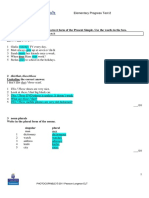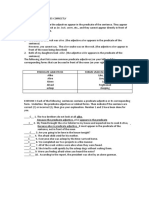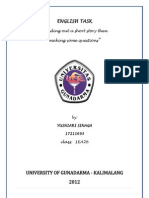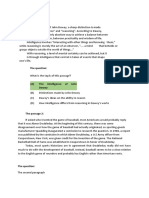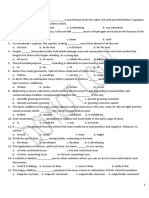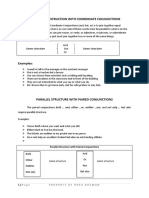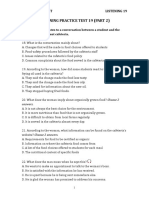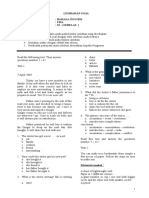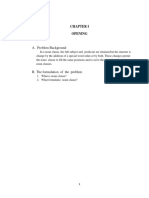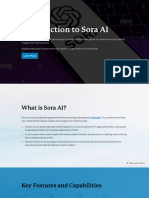Pertemuan 10 - Noun Clause and Adverb Clause
Pertemuan 10 - Noun Clause and Adverb Clause
Uploaded by
rama amazingCopyright:
Available Formats
Pertemuan 10 - Noun Clause and Adverb Clause
Pertemuan 10 - Noun Clause and Adverb Clause
Uploaded by
rama amazingOriginal Title
Copyright
Available Formats
Share this document
Did you find this document useful?
Is this content inappropriate?
Copyright:
Available Formats
Pertemuan 10 - Noun Clause and Adverb Clause
Pertemuan 10 - Noun Clause and Adverb Clause
Uploaded by
rama amazingCopyright:
Available Formats
Modul Bahasa Inggris 2
MEETING 10
NOUN CLAUSE AND ADVERB CLAUSE
A. OBJECTIVE OF THE STUDY
After studying this meeting, the students will be able to :
10.1 Understand about noun clause
10.2 Understand the strategy of noun clause on TOEFL test
10.3 Understand about adverb clause
10.4 Understand the strategy of adverb clause on TOEFL test
B. MATERIAL DESCRIPTION
Study Objective 10.1:
Understand about Noun Clause
1. NOUN CLAUSE
A noun clause is a subordinate clause. A noun clause has a subject and a verb,
and can be used like a noun, either as a subject or an object.
a. As Subject
His discovery was important.
Noun
His discovery is a noun. It is the subject of the sentence.
What he discovered was important.
Noun clause
What he discovered is a noun clause. It is the subject of the sentence. It has a
subject he and a verb discovered.
S1 Sastra Indonesia Universitas Pamulang Page 98
Modul Bahasa Inggris 2
b. As Object
People believed his discovery.
Noun
His discovery is a noun. It is the object of the verb believed.
People believed what he discovered.
Noun clause
What he discovered is a noun clause. It is the object of the verb believed.
Noun clauses are introduced by the following words:
when who/whom whether that
where what if
why which
how whose
c. Noun Clauses Beginning with a Question Word
Question words such as when, where, why, how, who/whom, what, which, and
whose can introduce a noun clause.
Question Noun Clause
1. What did he discover? I don’t know what he discovered.
2. When did he discover it? I’m not sure when he discovered it.
3. Where did he discover it? It is not known where he discovered it.
4. How did he discovery it? I’m not certain how he discovered it.
5. Who is Faraday? I don’t know who he is.
6. Whose discovery is that? It is not certain whose discovery that is.
7. What did he discover? What he discovered is not certain. (What is
The subject of the sentence)
STRATEGY
Do not use question word order in a noun clause. The subject comes before the verb
in a noun clause.
S1 Sastra Indonesia Universitas Pamulang Page 99
Modul Bahasa Inggris 2
Noun Clauses Beginning with whether or if
When a yes/no question is changed to a noun clause whether of is used to
Question Noun clause
Will it work? He wonders whether it will work
He wonders if it will work
Did they believe him? l don’t know whether they believed him.
l don’t know believed him
d. Noun Clauses Beginning with That
For a statement of a fact or an idea, the word that is used introduce the noun
clause.
Statement Noun Clause
1. The world is round. We know that the world is round. (That the
world is round is the object of the verb
know).
2. The world is round. We know the world is round. (The word that
is frequently omitted in spoken English).
3. The world is round. That the world is round is a fact. (That the
world is round is the subject of the sentence.
The word that cannot be omitted when it
introduces a noun clause that is the subject of
a sentence).
STRATEGY
A noun clause must have a subject and a verb. Look for a subject and a verb when the
noun clause is the object or the subject of a sentence.
S1 Sastra Indonesia Universitas Pamulang Page 100
Modul Bahasa Inggris 2
Study Objective 10.2:
Understand the Noun Clause on TOEFL Test
2. ON TOEFL TEST
A noun clause is a clause that functions as a noun; because the noun clause
functions as a noun, it can be used in a sentence as an object of a verb (if it follows a
verb) or an object of a preposition (if it follows a preposition).
The following example shows how these sentence patterns could be tested in the
Structure section of the TOEFL test
Example
The citizens worry about ____ is doing.
(A) what the government
(B) the government
(C) what
(D) what the government it
In this example, the sentence contains the main subject and verb, the citizens worry, and
it also contains an additional verb, is doing. The sentence needs a subject for the verb is
doing and a connector to join the two clauses. The best answer is answer (A) because it
has the connector what and the subject government. Answer (B) is incorrect because it
does not have a connector. Answer (C) is incorrect because it does not have a subject
for is doing. Answer (D) is incorrect because it has two subjects for is doing.
S1 Sastra Indonesia Universitas Pamulang Page 101
Modul Bahasa Inggris 2
Study Objective 10.3:
Understand about adverb clause
An adverb is a subordinate clause (dependent clause) with a subject and a verb. An
adverb clauses may come before or alter the main clause (dependent clause). When it
come before the main clause or the beginning, it is usually separated from the main
clause by a comma.
When Ali looked at the small points, he saw galaxies.
Ali saw galaxies when he looked at the small points.
Adverb Clause Markers
The following are some common words used to introduce an adverb clause.
1. Clause Markers Showing Time :
After by the time until
as once when
before since whenever
as soon as till while
Example:
❖ Meteors glow as they burn up in the atmosphere.
From the example above, as has a function to show the time.
❖ It was difficult to observe the stars before the telescope was
invented.
From the example above, before has a function to show the time.
S1 Sastra Indonesia Universitas Pamulang Page 102
Modul Bahasa Inggris 2
3. Clause Markers Showing Manner:
as as it as though just as like
Example:
❖ Ancient people used the stars as if they were calendars.
From the example above, as has a function to show the manner.
❖ The milky way looks as though it is a faint band of light.
From the example above, as though has a function to show the
time.
3. Clause Markers Showing Cause and Effect:
because since as
now that as long as so that
Example:
❖ Spacesuits were designed for astronauts so that they could
breathe in space.
From the example above, so that has a function to show cause
and effect.
4. Clause Markers Showing Opposition:
although while
though whereas
even though
S1 Sastra Indonesia Universitas Pamulang Page 103
Modul Bahasa Inggris 2
Example:
❖ Most stars are white while some are colored.
From the example above, while has a function to show
opposition.
❖ Although helium is rare on earth, it is common in the universe.
From the example above, although has a function to show cause
and effect.
5. Clause markers showing condition :
If provided that
Example:
❖ You will see hundreds of stars if you look at the sky.
From the example above, if has a function to show condition.
6. Clause markers showing purpose :
So that in order that so (that) In order to
Example:
❖ Astronomers improved telescopes so that they would discover
more about the stars.
From the example above, so that has a function to show purpose.
7. Clause markers showing result :
So … that such … that
S1 Sastra Indonesia Universitas Pamulang Page 104
Modul Bahasa Inggris 2
Example:
The stars are so far away that they cannot be seen without a telescope.
From the example above, so that has a function to show result.
8. Clause markers showing place :
Where wherever everywhere
Example:
❖ There were stars wherever she looked.
From the example above, wherever has a function to show place.
Study Objective 10.4:
Understand the strategy of adverb clause on TOEFL test
1. ON THE TOEFL TEST
Adverb clauses are tested in the Structure part of the exam. In these items, any part
of the adverb clause may be missing from the stem; it may be the clause marker, the
subject, the verb, or other parts of the clause.
It is important to remember the following:
1. An adverb clause contains a subject and a verb.
2. A reduced adverb clause does not contain a subject and a verb.
3. Use the correct clause marker for the adverb clause.
ex: the solar system may seem big, it is a very small part of the universe.
(A) Despite
(B) Although
(C) Even though it
(D) Because
The best answer is (B). (A) is incorrect because despite cannot be used in an adverb
clause that has a subject and a verb. (C) is incorrect because it contains a subject, it,
which is repealed again in the same clause. (D) is incorrect because because it contains
the wrong clause marker, giving reason Instead of concession.
S1 Sastra Indonesia Universitas Pamulang Page 105
Modul Bahasa Inggris 2
ex:
Ancient astronomers looked at the stars could make predictions about the future.
(A) they
(B) so
(C) so that they
(D) as they
The best answer is (C).
C. EXERCISE
Exercise 1
Directions: from the four words or phrases (A),(B),(C) OR ,(D), choose the one that
best completes the sentence
1. Astronomers studied the 1987 supernova to learn _____ when a star explodes.
(A) What happens
(B) That happens
(C) That is happen
(D) What does happen
2. Despite recent attempts to prove _____ did indeed reach the North Pole in 1909,
the evidence still remains questionable.
(A) what Robert peary
(B) That Robert peary
(C) Robert peary, who
(D) Robeart peary was
3. Around 1789, Antoine Lavoisler was the first person to demonstrate____ all
kinds of burning involve the edition of oxygen.
(A) if (C) that
(B) what (D) so that
S1 Sastra Indonesia Universitas Pamulang Page 106
Modul Bahasa Inggris 2
4. Where_____ is the commonest from of color blindness.
(A) are the red and green not easily distinguished
(B) they are not easily distinguished red and green
(C) are not easily distinguished red and green
(D) red and green are not easily distinguished
5. It has been estimated _____milligram of skin scales have over hall a million
bacteria
(A) that a
(B) how a
(C) a
(D) to be a
6. It is only in the last 200 years______have begun climbing mountains.
(A) because people
(B) that people
(C) people
(D) as peole
7. ______ of smell might without our realizing it, affect who we choose as friends
has been suggested
(A) that our sense
(B) sense
(C) for our sense
(D) because our sense
8. From the existence of radio waves ,most scientists were convinced _____ really
happened
(A) the big bang was
(B) it was the big bang
(C) how the big bang
(D) that the big bang
S1 Sastra Indonesia Universitas Pamulang Page 107
Modul Bahasa Inggris 2
9. Samples of rock showed____4600 milion yeasr old
(A) That the moon is
(B) How is the moon
(C) When is the moon
(D) To be the moon
10.____was lowered to the sea bed in a glass container to make observations is
debated.
(A) Alexander the great who
(B) Whether alexander the great
(C) Alexander the great
(D) What alexander the great
11. ____ so incredible is that it can grow 385 miles of roots in four months ,or about
3 miles in a day.
(A) That makes the rye plant
(B) What makes the rye plant
(C) The rye plant
(D) The rye plant which was
12. Science fiction writers believe___ in the future, with new material and greater
knowledge, their vision will become reality.
(A) That they
(B) They
(C) That
(D) They will
EXERCISE 2
Choose the correct adverb clause marker from the parentheses.
1. Quasars are an important discovery (because/although) they are the most
powerful objects ever seen.
2. The outer planers are cooler than the inner ones (as/wheneras) they are further
from the sun.
S1 Sastra Indonesia Universitas Pamulang Page 108
Modul Bahasa Inggris 2
3. A black hole is a region of space (where/whenever) the gravitational pull is so
strong that nothing can escape.
4. Radio waves from distant regions of space could be studied (while/after) the
radio telescope was invented.
5. Telescopes see distant objects more clearly (whereas/because) radio telescopes
collect radio waves.
6. Astronomers did not know about quasars (before/so that)radio telescopes were
invented.
D. REFERENCE
Azar, Betty Scrampfer. 1992. Fundamentals English Grammar second edition. New
Jersey: Prentice Hall.
Broukal, Milada, TOEFL Test Asistant:Grammar, Heinle & Heinle Publisers : USA.
Frank, Marcella. 1972. Modern English a practical reference guide. New Jersey:
Prentice Hall.
Nettle, Mark and Hopkind, Diana, Developing Grammar in Context, Grammar
Reference and Practice. Italy: Cambridge University Press
S1 Sastra Indonesia Universitas Pamulang Page 109
You might also like
- A. Wild Animals in Art C. Exploring Caves Respectfully D. Determining The Age of French CavesDocument3 pagesA. Wild Animals in Art C. Exploring Caves Respectfully D. Determining The Age of French CavesZeerak KhanNo ratings yet
- Present Perfect TenseDocument9 pagesPresent Perfect TenseKhoerul AnwarNo ratings yet
- Scientific Method WS With Bar GraphDocument4 pagesScientific Method WS With Bar GraphJessa Masamoc0% (1)
- TENE ELEM ProgressTest02Document4 pagesTENE ELEM ProgressTest02JOSE LUIS JUNIOR RICHARDS RIVASNo ratings yet
- Exercise Pattern Organization - Dayini Syahirah - D071191045 - Teknik IndustriDocument4 pagesExercise Pattern Organization - Dayini Syahirah - D071191045 - Teknik IndustridayiniNo ratings yet
- Contoh Tugas Structure Tentang Like, Alike, UnlikeDocument2 pagesContoh Tugas Structure Tentang Like, Alike, UnlikeULVA H.R.No ratings yet
- Structure Skill 9-12Document4 pagesStructure Skill 9-12indah lestari100% (1)
- Noun ClauseDocument7 pagesNoun ClauseremembermeNo ratings yet
- Elizabeth BlackwellDocument4 pagesElizabeth BlackwellYusni SinagaNo ratings yet
- Unit 10 Reading Comprehension: General StrategiesDocument19 pagesUnit 10 Reading Comprehension: General StrategiesDita Indah RahmawatiNo ratings yet
- Practice Test Mba1Document4 pagesPractice Test Mba1Rani Permata0% (1)
- Toefl TestDocument16 pagesToefl TestSephianNo ratings yet
- Exercise (Reading)Document4 pagesExercise (Reading)nova aldin2015No ratings yet
- Part 1-Structure - To Reading ComprehensionDocument11 pagesPart 1-Structure - To Reading Comprehensionrhiza may tigasNo ratings yet
- Structure Content: 1. EXERCISE 1 (Skill 1-2) 2. Toefl Review Exercise (Skill 1-2) 3. Answer KeysDocument3 pagesStructure Content: 1. EXERCISE 1 (Skill 1-2) 2. Toefl Review Exercise (Skill 1-2) 3. Answer Keysjo_jo_mania0% (1)
- Kumpulan Materi Phonetics PhonologyDocument5 pagesKumpulan Materi Phonetics PhonologyHero TranNo ratings yet
- UNIT1000Document13 pagesUNIT1000Houn Thon HSNo ratings yet
- Next Last After at Last Finally Later Beforer While at The Same TimeDocument3 pagesNext Last After at Last Finally Later Beforer While at The Same Timedewi siswitaNo ratings yet
- Tips and Trick Menjawab Soal Structure TOEFLDocument10 pagesTips and Trick Menjawab Soal Structure TOEFLMichael Oktavianus Dwi PutraNo ratings yet
- TOEFL Meeting 11Document18 pagesTOEFL Meeting 11Rini FitriastutiNo ratings yet
- Unity and Coherence CDocument5 pagesUnity and Coherence CTuấn Khanh VõNo ratings yet
- Soal Latihan TOEFLDocument31 pagesSoal Latihan TOEFLahmadnasihinNo ratings yet
- Latihan Soal TOEFLDocument22 pagesLatihan Soal TOEFLivan qNo ratings yet
- Parallel Construction and Paired Conjunction-UpdatedDocument3 pagesParallel Construction and Paired Conjunction-UpdatedRengga SebastianNo ratings yet
- Subclauses - Noun Clause, Adverb Clause, Adjective Clause - Draft 1Document8 pagesSubclauses - Noun Clause, Adverb Clause, Adjective Clause - Draft 1Mhd IcanNo ratings yet
- Strategies For TOEFL Listening Part CDocument12 pagesStrategies For TOEFL Listening Part CZaeni Interisti SejatiNo ratings yet
- Structure, Skill 6-10Document10 pagesStructure, Skill 6-10leon_blizzaraNo ratings yet
- Toefl Ibt - Reading Section - Passage 1 - Mock TestDocument7 pagesToefl Ibt - Reading Section - Passage 1 - Mock Testnaomidelcastillo2No ratings yet
- Practice TOEFL StructureDocument2 pagesPractice TOEFL StructureacengNo ratings yet
- TOEFL - Structure AdityaDocument7 pagesTOEFL - Structure AdityaadityaNo ratings yet
- TOEFL Structure Skills Part1Document25 pagesTOEFL Structure Skills Part1JanuardiTriHanantoNo ratings yet
- Monster Hunter 2 (Dos) PiggyDocument2 pagesMonster Hunter 2 (Dos) PiggySlider TookayNo ratings yet
- Listening Practice Test 19 - Part 2Document4 pagesListening Practice Test 19 - Part 2Nguyễn Hoàng SơnNo ratings yet
- MSRT Question Sample 2Document6 pagesMSRT Question Sample 2sinaNo ratings yet
- Soal TO TBI FixDocument10 pagesSoal TO TBI FixkholibNo ratings yet
- Toefl 2Document12 pagesToefl 2YzifarNo ratings yet
- Genres of TextsDocument4 pagesGenres of TextstehithaNo ratings yet
- ToeflDocument33 pagesToeflSunedi SudarmanNo ratings yet
- Nama: Wulanda Arta Mevia NPM: 11520102 Kelas: 1PA30 Tugas Mata Kuliah Bahasa Inggris "Project 12"Document3 pagesNama: Wulanda Arta Mevia NPM: 11520102 Kelas: 1PA30 Tugas Mata Kuliah Bahasa Inggris "Project 12"1PA30Wulanda Arta MeviaNo ratings yet
- Muhammad Daffa DR-191734022-2D TKE (Exercie 2&3)Document3 pagesMuhammad Daffa DR-191734022-2D TKE (Exercie 2&3)MUHAMMAD DAFFA DWITAMA RIDWAN -No ratings yet
- Nouns and Pronouns: TOEFL Short CourseDocument52 pagesNouns and Pronouns: TOEFL Short CourseZahira Mumtaza23No ratings yet
- D091181006 - Muh. Zaid Iskandar - Exercise 9Document2 pagesD091181006 - Muh. Zaid Iskandar - Exercise 9MyazielNo ratings yet
- Toefl 2Document18 pagesToefl 2Rika IndriyaniNo ratings yet
- Soal Bahasa Inggris Kls XI SMADocument6 pagesSoal Bahasa Inggris Kls XI SMArahmah indriNo ratings yet
- Lesson 2 Kelip-Introduction To Articulatory PhoneticsDocument17 pagesLesson 2 Kelip-Introduction To Articulatory PhoneticsMUHAMMAD ALIFF QAYYUM BIN ABDULLAH MoeNo ratings yet
- 10 Reading Question TypesDocument10 pages10 Reading Question TypesChaterineNo ratings yet
- TOEFL DAY ONE (Unedited)Document111 pagesTOEFL DAY ONE (Unedited)selma giolinnaNo ratings yet
- Latihan Soal SNMPTN 2011 B. Inggris 336Document6 pagesLatihan Soal SNMPTN 2011 B. Inggris 336Asriadi AzisNo ratings yet
- 02.bahasa Inggris II LISTEN FOR NEGATIVE EXPRESSIONSDocument3 pages02.bahasa Inggris II LISTEN FOR NEGATIVE EXPRESSIONSFahfu Rozy100% (1)
- Noun ClauseDocument9 pagesNoun ClauseDarma WatiNo ratings yet
- Kartu Soal Bahasa Inggris XIIDocument7 pagesKartu Soal Bahasa Inggris XIICut FitriasariNo ratings yet
- EXERCISE Skill 3-5Document3 pagesEXERCISE Skill 3-5ChacaNo ratings yet
- Test TOEFLDocument10 pagesTest TOEFLazies rachmanNo ratings yet
- TOEFL Test (Reading)Document10 pagesTOEFL Test (Reading)Misbahul MunirNo ratings yet
- 6 Inverted Subject & VerbDocument27 pages6 Inverted Subject & VerbUlfah NursyarifahNo ratings yet
- 2 Tes 209 StructureDocument5 pages2 Tes 209 Structuredgrimjoww 21No ratings yet
- TOEFELDocument13 pagesTOEFELOktaviaNo ratings yet
- How To Write Business Letters in EnglishDocument12 pagesHow To Write Business Letters in EnglishBelinha FerreiraNo ratings yet
- Grammar Module - 4Document29 pagesGrammar Module - 4Ella YahalabNo ratings yet
- Noun ClauseDocument3 pagesNoun ClauseสถาบันภาษาอาภาพชรNo ratings yet
- 06 Complex SentenceDocument5 pages06 Complex SentenceAre prety neldaNo ratings yet
- A. Problem Background: OpeningDocument8 pagesA. Problem Background: OpeningHono JoeNo ratings yet
- CURRENT ISSUES IN SYNTAX Course OutlineDocument1 pageCURRENT ISSUES IN SYNTAX Course OutlinePuenea Ionut MariusNo ratings yet
- Whats Your RasheeDocument20 pagesWhats Your Rasheedream1968No ratings yet
- Exploring The Factors Affecting Learning Motivation of LNU Social Studies Major Amidst Online Learning ExperienceDocument17 pagesExploring The Factors Affecting Learning Motivation of LNU Social Studies Major Amidst Online Learning ExperienceInternational Journal of Innovative Science and Research TechnologyNo ratings yet
- DilshanThapa CVDocument1 pageDilshanThapa CVpriyanshi samuchiwalNo ratings yet
- Curriculum Map: Grade 7: ECAS Through Philippine Literature Program StandardDocument62 pagesCurriculum Map: Grade 7: ECAS Through Philippine Literature Program StandardDhianne De GuzmanNo ratings yet
- Greek For TravelersDocument119 pagesGreek For TravelersApostolos Koutropoulos50% (2)
- Conditions of LearningDocument22 pagesConditions of LearningLuna Cecille100% (1)
- English Lexicology (Reader) PDFDocument145 pagesEnglish Lexicology (Reader) PDFVũ Tuấn AnhNo ratings yet
- Martha Peláez - Morality As A System of Rule-Governed Behavior and EmpathyDocument7 pagesMartha Peláez - Morality As A System of Rule-Governed Behavior and EmpathyIrving Pérez MéndezNo ratings yet
- Hawkins Bab 2Document12 pagesHawkins Bab 2Christian MamuajaNo ratings yet
- American English File Level 1Document12 pagesAmerican English File Level 1Andrea Pereira100% (2)
- NRP Q2-Week 5Document6 pagesNRP Q2-Week 5ARLYNP AQUINONo ratings yet
- Unit Ii ModelingDocument15 pagesUnit Ii ModelingSASIKALA C CS106No ratings yet
- To Catch A ThiefDocument10 pagesTo Catch A ThiefmissavelloNo ratings yet
- 2resume Yuldashev SherzodDocument3 pages2resume Yuldashev SherzodШерзод ЮлдашевNo ratings yet
- Practical Research 1 - 11 - Q2 - M12Document15 pagesPractical Research 1 - 11 - Q2 - M12Akisha Fijo100% (1)
- Meditation 5Document12 pagesMeditation 5taddeus.occhyNo ratings yet
- Subject Assignment: Teaching Pronunciation: General InformationDocument9 pagesSubject Assignment: Teaching Pronunciation: General InformationVictor M. Jaimes MolinaNo ratings yet
- Responses To Sceptical Essays: Barry StroudDocument16 pagesResponses To Sceptical Essays: Barry Stroudpaula zorziNo ratings yet
- Philo WK 1Document22 pagesPhilo WK 1Khaze LaurelNo ratings yet
- Introduction To Sora AIDocument10 pagesIntroduction To Sora AIHYPER EMPERERNo ratings yet
- Đề thi HSG cấp tỉnh môn Tiếng Anh 12Document10 pagesĐề thi HSG cấp tỉnh môn Tiếng Anh 12Khoa DangNo ratings yet
- Culture and Society in The Globalizing WorldDocument5 pagesCulture and Society in The Globalizing WorldGwen YahinNo ratings yet
- 10 Principles of Effective Learning & TeachingDocument2 pages10 Principles of Effective Learning & TeachingUMinnTeachLearn100% (1)
- DLL-Earth and Life Science 1012Document3 pagesDLL-Earth and Life Science 1012Jonas Miranda CabusbusanNo ratings yet
- Coping Mechanism of College of Teacher Education Students Towards Their Problems Faced During Speaking in Relation To Their Oral Language ProficiencyDocument9 pagesCoping Mechanism of College of Teacher Education Students Towards Their Problems Faced During Speaking in Relation To Their Oral Language Proficiencyveronica magayNo ratings yet
- Lingüística Hispánica Actual: Guía Didáctica y Materiales de ApoyoDocument16 pagesLingüística Hispánica Actual: Guía Didáctica y Materiales de ApoyoomarangelNo ratings yet
- Rhythm and Beat Perception in Motor Areas of The Brain: Jessica A. Grahn and Matthew BrettDocument24 pagesRhythm and Beat Perception in Motor Areas of The Brain: Jessica A. Grahn and Matthew BrettAnn FeeNo ratings yet



